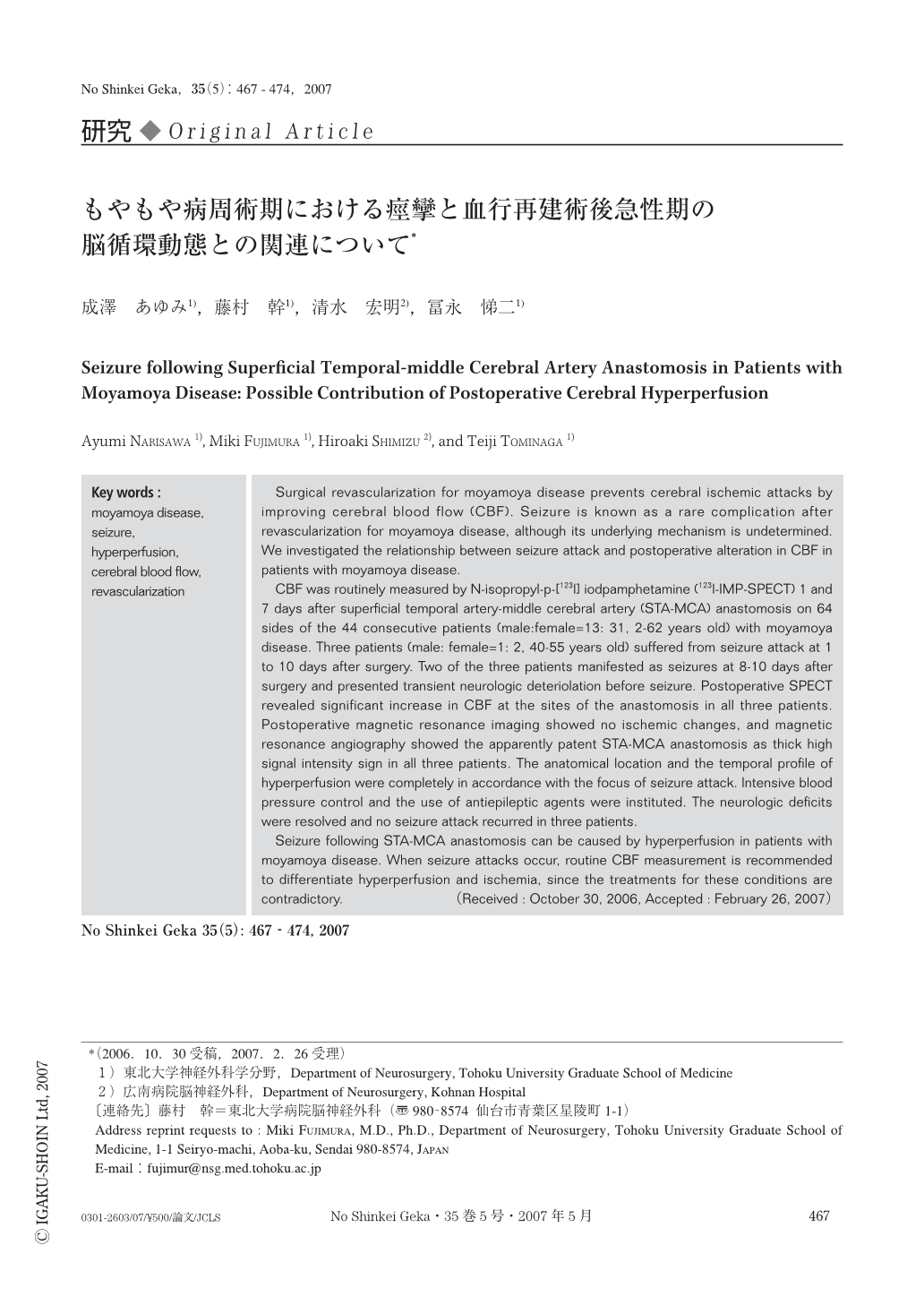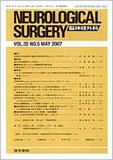Japanese
English
- 有料閲覧
- Abstract 文献概要
- 1ページ目 Look Inside
- 参考文献 Reference
Ⅰ.はじめに
もやもや病は両側内頸動脈終末部,前およびに中大脳動脈近位部が進行性に狭窄・閉塞し,その付近に異常血管網の発達を認める原因不明の疾患である14).浅側頭動脈・中大脳動脈(STA-MCA)吻合術は本疾患による脳虚血を改善するための有効な治療法として広く用いられているが3,5,12),もやもや病に対するバイパス術後急性期の臨床症状や血行再建による急激な血流増加が脳循環代謝に与える影響についてはいまだ不明な点が多い.
われわれは2004年3月以降もやもや病バイパス全手術症例に対して術後急性期にN-isopropyl-p-[123I]iodpamphetamine(123I-IMP-SPECT)による脳血流の評価を行い,バイパス吻合部位周囲の局所的高灌流が虚血発作に類似した一過性局所神経脱落症状の原因となっていることを明らかにし術後急性期の病態把握の重要性を報告してきた1-3).一方,痙攣はもやもや病周術期の稀な合併症として知られているが,その機序については明らかでない.本研究では,当施設においてSTA-MCA吻合術を施行したもやもや病連続症例の中で術後痙攣発作を合併した症例に注目し,術後急性期の脳循環動態との関連について検討を行った.
Surgical revascularization for moyamoya disease prevents cerebral ischemic attacks by improving cerebral blood flow (CBF). Seizure is known as a rare complication after revascularization for moyamoya disease, although its underlying mechanism is undetermined. We investigated the relationship between seizure attack and postoperative alteration in CBF in patients with moyamoya disease.
CBF was routinely measured by N-isopropyl-p-[123I] iodpamphetamine (123I-IMP-SPECT) 1 and 7 days after superficial temporal artery-middle cerebral artery (STA-MCA) anastomosis on 64 sides of the 44 consecutive patients (male:female=13: 31, 2-62 years old) with moyamoya disease. Three patients (male: female=1: 2, 40-55 years old) suffered from seizure attack at 1 to 10 days after surgery. Two of the three patients manifested as seizures at 8-10 days after surgery and presented transient neurologic deteriolation before seizure. Postoperative SPECT revealed significant increase in CBF at the sites of the anastomosis in all three patients. Postoperative magnetic resonance imaging showed no ischemic changes, and magnetic resonance angiography showed the apparently patent STA-MCA anastomosis as thick high signal intensity sign in all three patients. The anatomical location and the temporal profile of hyperperfusion were completely in accordance with the focus of seizure attack. Intensive blood pressure control and the use of antiepileptic agents were instituted. The neurologic deficits were resolved and no seizure attack recurred in three patients.
Seizure following STA-MCA anastomosis can be caused by hyperperfusion in patients with moyamoya disease. When seizure attacks occur, routine CBF measurement is recommended to differentiate hyperperfusion and ischemia, since the treatments for these conditions are contradictory.

Copyright © 2007, Igaku-Shoin Ltd. All rights reserved.


